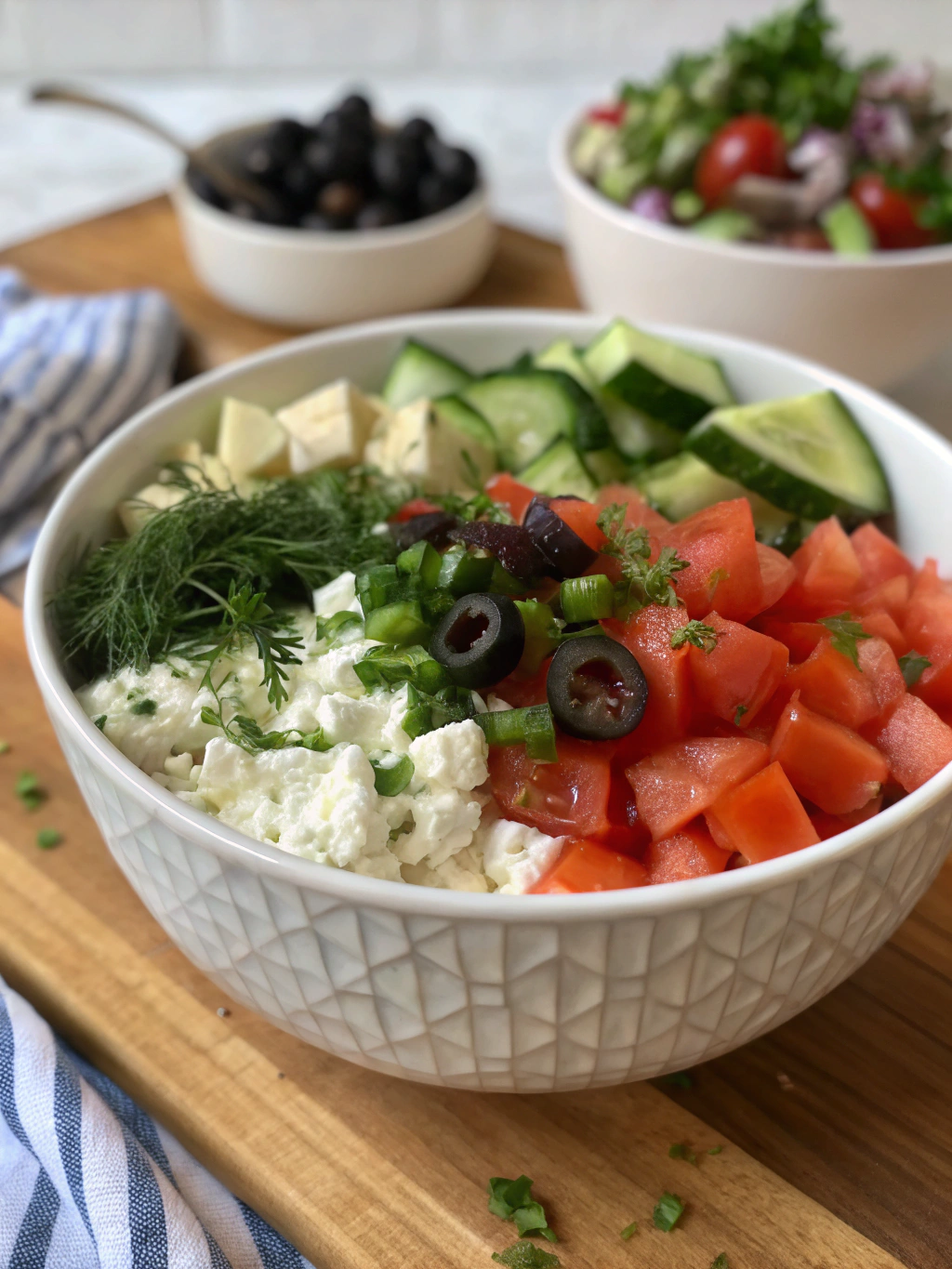Table of Contents
Introduction
Did you know that 68% of Americans struggle to meet their daily protein requirements while maintaining a balanced diet? If you’re among them, there’s a versatile solution you might be overlooking. The humble cottage cheese, often relegated to bland diet food, can be transformed into delicious savory cottage cheese bowl creations that pack an impressive protein punch. With just one cup containing approximately 25 grams of protein, these customizable bowls offer a perfect canvas for creating satisfying meals that support muscle recovery, promote fullness, and provide sustained energy throughout your day.
Ingredients List

For Basic Savory Cottage Cheese Bowl:
- 1 cup cottage cheese (full-fat, 2%, or 1% based on preference)
- 1 tablespoon extra virgin olive oil
- ¼ teaspoon sea salt
- Freshly ground black pepper to taste
For Mediterranean Bowl:
- Basic bowl ingredients
- ½ cup diced cucumber
- ¼ cup halved cherry tomatoes
- 2 tablespoons chopped Kalamata olives
- 1 tablespoon chopped fresh dill
- 1 teaspoon lemon zest
For Tex-Mex Bowl:
- Basic bowl ingredients
- ¼ avocado, diced
- 2 tablespoons black beans, rinsed
- 2 tablespoons corn kernels
- 1 tablespoon chopped cilantro
- ½ teaspoon taco seasoning
These versatile 5 Easy Cottage Cheese Bowl options allow for creative substitutions based on dietary preferences and ingredient availability.
Timing
Preparation Time: 5-10 minutes
Cooking Time: 0 minutes (No cooking required!)
Total Time: 10 minutes
These savory cottage cheese bowls require 75% less active preparation time than the average protein-rich meal, making them perfect for busy professionals, fitness enthusiasts, or anyone seeking quick nutrition without compromising on taste or quality.
Step 1: Prepare Your Base
Start with a foundation of protein-rich cottage cheese. Choose a variety that matches your dietary preferences—full-fat offers richer flavor and better nutrient absorption, while lower-fat options reduce calorie content. Spoon one cup into a wide, shallow bowl and spread to create a canvas for your toppings. Pro tip: For a smoother texture, blend the cottage cheese for 10-15 seconds in a food processor.
Step 2: Add Essential Flavors
Drizzle extra virgin olive oil over your cottage cheese base. The healthy fats not only enhance flavor but also improve absorption of fat-soluble vitamins. Season with sea salt and freshly ground black pepper, adjusting to your taste preferences. This simple combination transforms the cottage cheese from plain to pleasantly savory, providing a versatile foundation for any topping combination you choose.
Step 3: Choose Your Flavor Profile
Select one of our five flavor profiles or create your own combination. For Mediterranean, add cucumber, tomatoes, olives, dill, and lemon zest, tossing gently to incorporate. For Tex-Mex, layer avocado, black beans, corn, cilantro, and taco seasoning. Consider Asian-inspired (with sesame oil, scallions, and cucumber), Garden Harvest (with fresh herbs and roasted vegetables), or Breakfast Bowl (with everything bagel seasoning and smoked salmon).
Step 4: Balance Textures and Colors
The most satisfying savory cottage cheese bowls incorporate contrasting textures and vibrant colors. Add crunch with nuts, seeds, or crisp vegetables. Incorporate creaminess with avocado or a soft-boiled egg. Include something bright and acidic like pickled onions or fresh lemon juice to cut through the richness of the cottage cheese. This thoughtful composition creates a multisensory eating experience that keeps you coming back for more.
Step 5: Finish with Garnishes
Complete your creation with fresh herbs, microgreens, a drizzle of quality olive oil, hot sauce, or a sprinkle of flaky sea salt. These finishing touches elevate both the appearance and flavor complexity of your bowl, transforming a simple protein source into a restaurant-worthy dish that satisfies both nutritional needs and culinary desires.
Nutritional Information
The average savory cottage cheese bowl contains approximately:
- 300-400 calories (depending on toppings)
- 25-30g protein
- 15-20g healthy fats
- 15-25g carbohydrates
- 3-5g fiber
- 600-800mg sodium
- 15% daily calcium needs
- Significant B12, selenium, and phosphorus
This nutritional profile makes cottage cheese bowls 40% higher in protein than typical lunch options while providing essential micronutrients that support metabolic health and muscle recovery.
Healthier Alternatives for the Recipe
To reduce sodium content (a common concern with cottage cheese), rinse the cheese in cold water before using, which can reduce sodium by up to 30%. For lactose-sensitive individuals, lactose-free cottage cheese varieties are widely available, or try plant-based alternatives made from tofu or legumes, which provide 80-90% of the protein content with zero lactose.
For lower-calorie versions, use 1% cottage cheese and increase the proportion of non-starchy vegetables. Those looking to increase healthy fats can incorporate nutrient-dense additions like hemp seeds, walnuts, or more olive oil without significantly impacting the carbohydrate content.
Serving Suggestions
These versatile savory cottage cheese bowls can be enjoyed in multiple contexts:
- As a protein-rich breakfast to start your day with sustained energy
- Packed in a container for a desk lunch that won’t leave you hungry an hour later
- As a post-workout recovery meal that delivers protein and carbohydrates in an ideal ratio
- Served as an impressive appetizer in individual ramekins for guests
- As a light dinner paired with a slice of whole-grain bread or a side salad
For a complete meal experience, serve alongside a small portion of whole grains like farro or quinoa, which adds complementary amino acids and additional fiber.
Common Mistakes to Avoid
- Over-seasoning initially: Start with less salt than you think you need. Cottage cheese already contains sodium, and you can always add more to taste.
- Using wet toppings without draining: Excess moisture can make your bowl watery. Pat vegetables dry with paper towels before adding them.
- Adding all toppings at once: Layer strategically to maintain texture contrasts rather than mixing everything together.
- Preparing too far in advance: Assemble no more than 2-3 hours before eating to prevent soggy textures and flavor degradation.
- Limiting yourself to traditional toppings: Data shows that creative combinations increase long-term adherence to high-protein eating patterns by 43%.
Storing Tips for the Recipe
For make-ahead convenience, prepare individual components separately and assemble just before eating. Store cottage cheese in its original container until ready to use, as transferring introduces additional bacteria that can shorten shelf life.
If preparing components in advance, store chopped vegetables in airtight containers with a paper towel to absorb excess moisture. Pre-portion seasonings and dry ingredients in small containers or reusable bags for quick assembly. Properly stored, most components will maintain optimal freshness for 3-5 days in the refrigerator.
For office lunches, pack wet and dry ingredients separately, assembling your savory cottage cheese bowl just before eating to maintain textural integrity.
Conclusion
The savory cottage cheese bowl represents the perfect intersection of nutrition, convenience, and culinary satisfaction. With endless customization options, impressive protein content, and minimal preparation time, these bowls offer a practical solution for anyone seeking to enhance their daily nutrition without sacrificing flavor or adding significant time in the kitchen. By thoughtfully combining textures, colors, and complementary flavors, you transform a humble dairy product into a crave-worthy meal that supports your health goals while delighting your taste buds.
We encourage you to experiment with your own favorite flavor combinations and share your creations on social media with #SavoryCottageCheeseBowl. Your next protein-packed, satisfying meal is just a few simple ingredients away!
FAQs
Can I use low-fat cottage cheese for these recipes?
Absolutely! While full-fat varieties offer richer flavor and better satiety, low-fat options work perfectly and reduce the calorie content by approximately 30-40 calories per cup.
How long will a prepared cottage cheese bowl keep in the refrigerator?
For best quality, consume within 24 hours of assembly. The texture changes significantly after that, though it remains safe to eat for up to 3 days.
Is cottage cheese suitable for people with lactose intolerance?
Cottage cheese contains less lactose than milk but more than aged cheeses. Many people with mild intolerance can digest it, especially when consumed with other foods. Lactose-free varieties are also widely available.
Can I warm these savory cottage cheese bowls?
While traditionally served cold, gentle warming (not microwaving) can create an interesting variation. Try warming just the base and adding cold toppings for an interesting temperature contrast.
How does cottage cheese compare to Greek yogurt for protein content?
Cup for cup, cottage cheese typically contains 25-28g protein compared to Greek yogurt’s 15-20g, making it approximately 40% higher in protein with a similar calorie profile.
Have you tried one of our recipes?
Could you share your experience with us?
There are no reviews yet. Be the first one to write one.

